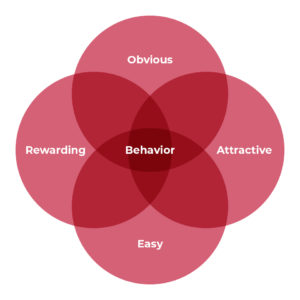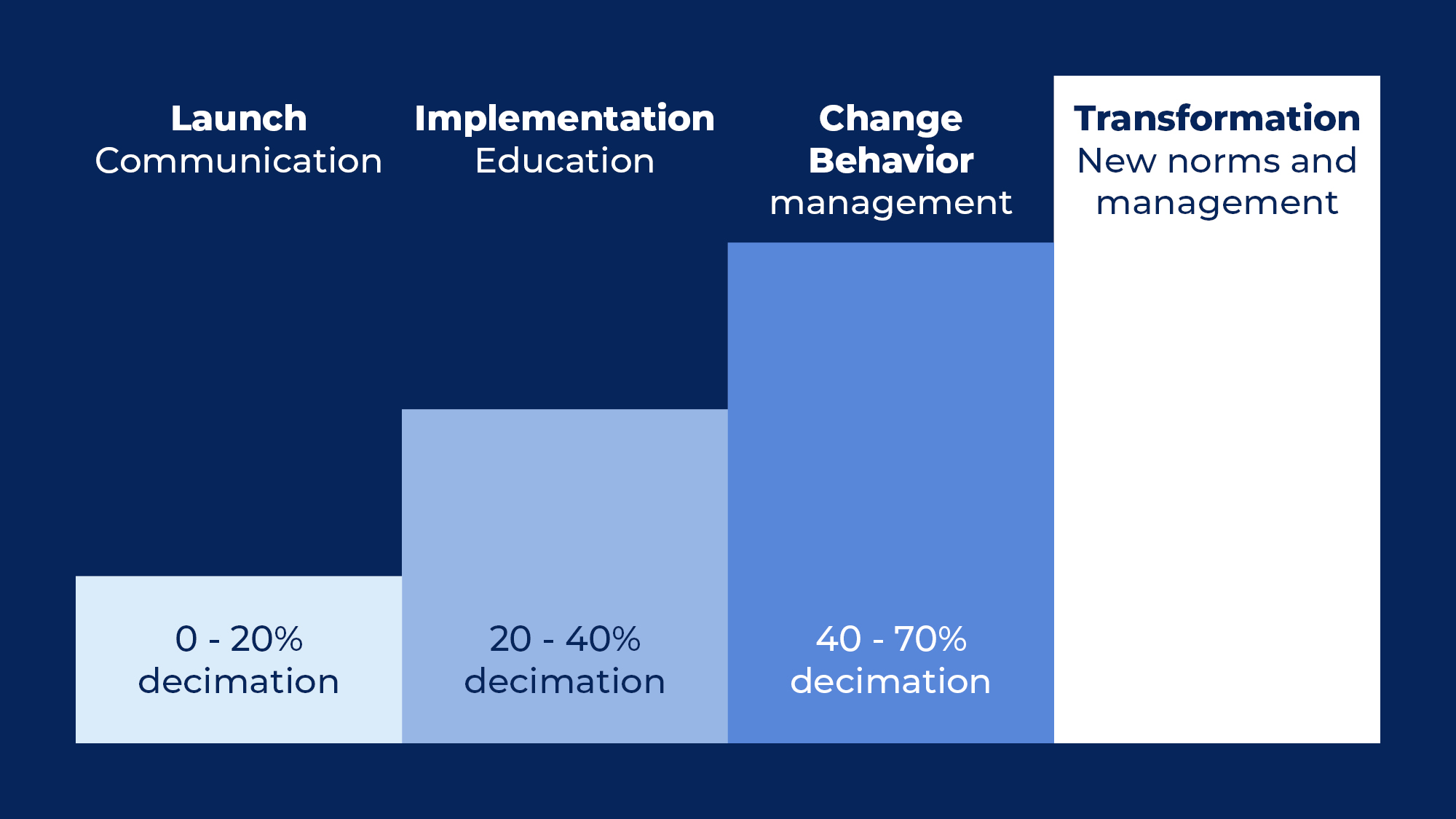Make it easy for the healthcare professionals to do the right thing

How can we overcome the power of habit through behavior management?
The journey from good intentions to action and changed behavior is not always easy in organizations.
We are creatures of habit and our brains play tricks on us in the most unpredictable ways. Often this leads to us doing something other than what we really want and think is best.
So even if we are motivated to use digital solutions, our habits can prevent us from changing our work routines.
Nudging and behaviour management is about making it easier for ourselves and others to get the right things done in a busy everyday life in clinical practice. With knowledge from such diverse fields as psychology, anthropology, biology and sociology, we can make it easier to do the right thing with simple steps.
Here are some tools that can inspire you to think in new ways of changing the behavior of your co-workers.
Communication, education and training is not enough to ensure, that new digital solutions are used wisely and efficiently. As depicted in the ‘Ladder of implementation’ experience shows that there is only up to 40 % decimation of new workflows and routines after training programs and implementation initiatives have taken place.
Creating changes in behavior and hereby changed workflows, routines and norms where new digital technology is used in ways that actually create value, takes more. It requires focus on how to manage behavior.
Manage behavior by breaking down the big changes into smaller steps and make them accesible and motivating.
When implementing changes in an organization, it is crucial that these are broken down into specific actions.
The manager must try to see the changes through the eyes of the healthcare professional and make a plan for how change is implemented by making the desired behavior obvious, attractive, easy and rewarding.

Obvious
Make the healthcare professional think: It is easy for me to understand what I have to do. It relates to my existing habits and workflows.
Advice for the manager:
- To avoid that the changes are seen as overwhelming, try to break them down into smaller steps that relate to existing workflows and habits.
- Make sure that the communication on behavioral expectations is very clear and concrete. Avoid talking about strategy and using ’buzz words’, which can be interpreted differently.
- Allow the healthcare professionals to explore which new workflows and routines work well when using a new technology.
Attractive
Make the healthcare professional think: I like what I have to do as it gives me advantages and leads to the person I want to be.
Advice for the manager:
- Highlight the positive effects of using digital technology, especially the advantages for the patient (citizen), who might experience faster, better and more flexible treatment.
- Encourage the healthcare professional to reflect on the value of the technology and to ask the patient (citizen) what the technology means to them. They might be surprised by their answer.
- Create a culture where using digital solutions is considered favourable and desirable by asking healthcare professionals to share their good stories at staff meetings.
Easy
Make the healthcare professional think: It is easy for me to do what I have to do. My surroundings guide me.
Advice for the manager:
- Make sure the digital solution is easy to access and that guidance is at hand for the healthcare professional when and where they use a new solution. A colleage may offer support and a user-friendly guide that is easy to find is a good start. Preferably a simple user-guide should be visible right where the digital solution is used.
- Try to make it easier to complete ones tasks with the technology than without.
- Give the healthcare professionals the time and occasion to practice the use of the new solution, reflect upon use together and become familiar with the solution.
Rewarding
Make the healthcare professional think: I repeat the action because I experience progress and get immediate feedback.
Advice for the manager:
- Give positive feedback to healthcare professionals who try to use the digital solution – even though they struggle and experience a hard time.
- Keep focusing on the progress the healthcare professionals make and acknowledge their improvement and effort. Be patient and accept that change takes time. This is why the manager must keep their focus for a long time.
Sources / References
- Richard H Thaler & Cass R Sunstein: Nudge – Improving Decisions About Health, Wealth and Happiness, 2009
- Welearm
- Richard H Thaler & Cass R Sunstein: Nudge – Improving Decisions About Health, Wealth and Happiness, 2009Learnings from eduactional programme for management of the digitalized health care sector (‘Ledelse i et digitaliseret sundhedsvæsen’) by HR Ledelsesakademiet Region Syddanmark and Network of responsibles for training of digital skills of healthcare professionals in hospitals of Region of Southern Denmark
Ladder of implementation

These are the rules of thumb – from intent to action
Carrot beats whip
We humans are motivated by the good and constructive. We prefer carrots over whips – meaning we prefer incentives over punishments.
So consider what carrots new digital technology offers the healthcare professionals who should be using them.
Social beats solo
We humans are social beings. When we have to change behavior, we like to do it with other people. Consider how to make new behavior social.
Ease beats motivation
When it comes to influencing human behavior, ease will almost always beat motivation. This is because while our motivation fluctuates up and down during the day, we see that for almost every choice we will choose the easiest solutions. So make sure to make it as easy as possible to use the digital solution; to find, book and access the equipment, to find and understand a guide of how to use it, to get support and help with troubleshooting, user names and passwords, to do documentation after use etc.
Little goes big
We humans like to think and set big goals – and that’s a good thing. But when it comes to turning ideas into new behavior, it is poison for your change. Instead, you have to work on starting small. Therefore, you might want to consider the smallest possible action you can take to get started with the changed workflows and habits.
Environment beats information
It is not always knowledge that leads to new behavior. In fact, we humans mostly use our surroundings to make decisions and take actions. If you want to change people’s behavior, you have to change their environment – exactly where you want them to do something new. Guides on how to use a solution or how to work differently should therefore be visible where the work is done and the physical space should be arranged in a way so that invites working in the new ways.
Timing always works
We humans are affected by time. When we talk about change and changing behavior, timing always wins. This means that there is much to be gained by carefully considering what time of year, month, week, day you choose to launch a new digital solution. In other words, you should consider when your target group is most receptive to accepting your change.
Followership beats leadership
We humans would rather follow a leader than be led to follow. Consider how to lead the change



